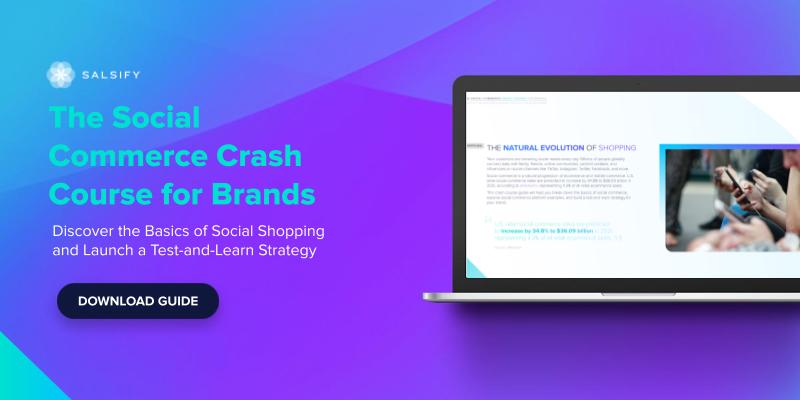It’s no secret that Amazon is the biggest ecommerce marketplace in the world and marks the start of many shopping journeys. But its huge user base means competition is fierce. It’s often not enough for brands to sprinkle in the right keywords, pump product pages with positive reviews, and snap high-res, high-quality images.
To put it simply: Selling on Amazon isn’t as easy as it used to be.
In the constantly evolving ecommerce landscape, partnerships with influencers on various channels empower brands to reach new audiences and ultimately boost sales. Amazon’s very own influencer program aims to connect brands with influencer stores to benefit both sides.
What Are Amazon Influencers, and What Is the Amazon Influencer Program?
The Amazon Influencer Program allows influencers to recommend products to their followers and earn a commission. Amazon influencers are often bloggers, YouTubers, and social media influencers who already have a large number of followers. They can set up their own personalized storefront on Amazon that links to their recommended products.
Brands then have the opportunity to partner with well-established influencers who can share their products with an engaged following.
The program isn’t open to everyone, though. Brands can be safe knowing that influencers have to pass a strict set of criteria to join the Amazon Influencer Program.
Amazon influencers need to:
- Have an active Instagram, YouTube, TikTok, or Facebook account;
- Have an established following (there’s no minimum);
- Regularly engage with their followers and viewers; and
- Create content that’s relevant to the products they’re promoting on Amazon.
The Amazon Influencer Program isn’t to be confused with Amazon Associates. Both get a commission through affiliate links, but associates send traffic to the original product pages on Amazon from other platforms, while influencers can generate a unique storefront URL that displays all of their chosen products in one place.
The commission varies from category to category. Amazon’s commission chart shows that Amazon Games can net influencers a huge 20% in commission, while beauty products can generate 10%. At the other end of the scale, influencers can get a 2% commission for digital video games and 2.5% for PC components.
What Is an Amazon Influencer Storefront, and How Does it Work?
Amazon influencers have the chance to create their very own personalized storefront on Amazon where they can curate their chosen products. As well as generating lists of similar products, influencers can publish livestreams, shoppable photos, videos, and other social commerce elements on their storefront to create an engaging landing page.
Influencers who take the time to put together an intuitive and attractive storefront have a higher chance of getting featured across Amazon. Brands should cherry-pick influencers who have a well-thought-out page for this reason. More visibility means more sales.
Image Source: Teresa Caruso's Amazon Page
For example, Tessa Caruso’s storefront features a personalized header, live streams, videos, and popular product categories for shoppers to browse.
The Rising Popularity of Amazon Influencers
The Amazon Influencer Program has been around since 2016, but its popularity has only begun to skyrocket over the last couple of years. TikTok has been a huge driver of its growth thanks to hundreds of TikTok stars who promote their Amazon finds or share “what I bought vs. what I got” videos that link to their storefront.
While both brands and creators benefit from the program, Amazon is making it increasingly attractive for influencers to come aboard. CNBC reports on the “Amazon Resort,” where the marketplace flew dozens of Amazon influencers out to a resort in Mexico. While there, they could attend sessions about optimizing their storefront, meet other creators, and enjoy the luxury beach resort.
The emphasis on nurturing influencer relationships and helping them bolster their storefronts hints at how important influencers are for Amazon. With the rise of TikTok and the all-important trust factor in ecommerce, there’s a good chance the Amazon Influencer Program will become increasingly powerful.
The Benefits of Amazon’s Influencer Program for Brands
While there are plenty of benefits of the Influencer Program for influencers (not least of which is the possibility of an all-expenses paid luxury trip to Mexico), there are many benefits for brands too.
More Sales
Influencers have already primed their audiences and do all the selling for you. It’s far easier to convert customers from a trusted source like an influencer than it is from pay-per-click (PPC) ads.
Enhanced SEO
More traffic to your product pages indicates to Amazon that your brand is popular. As a result, it will bump you up in the search results and improve your organic traffic from other sources.
Added Trust
Credibility is critical in ecommerce today, and the pre-built trust from influencers is automatically transferred to your brand.
Increased Brand Awareness
More mentions of your brand on social media and other platforms will expose you to new audiences who might not have found your products through Amazon search.
Ongoing Lead Generation
Influencer storefronts are available and searchable year-round, unlike social media ads that immediately stop running when you turn them off.
Comparing the ROI of Influencer Storefronts With Influencer Partnerships on Other Platforms
Influencer marketing has huge return-on-investment (ROI) potential. Influencer Marketing Hub’s “What Is Influencer Marketing? — The Ultimate Guide for 2024” found that the average earned media value per every $1 spent on influencer marketing is $5.2.
Instagram has long been the favorite influencer platform, but TikTok has dethroned it. Influencer Marketing Hub’s “The State of Influencer Marketing 2023” report states that TikTok is now the most popular influencer marketing channel, outranking Facebook, Instagram, and YouTube.
The benefit of Amazon’s Influencer Program is that brands can track direct sales from each partner. Tracking influencer marketing success on other platforms is still tricky due to unreliable tracking links and huge data gaps. Amazon’s refreshing take on the game could change all of that.
Seeing increased ROI from working with Amazon influencers will depend on the following:
- Who you’re partnering with and their leverage over their audience;
- The type of products you’re selling and how big their market is; and
- How many influencers you partner with and their account size.
Brands that partner with 20 niche influencers with highly engaged followings are likely to see a bigger ROI than brands that partner with one or two generic influencers who have very few followers or very little engagement on their accounts.
Is the Amazon Influencer Program Worth the Investment?
Yes, using Amazon influencers (and others) is definitely worth a try.
Influencer marketing is one of the most effective ways to promote ecommerce products since consumers rely heavily on word-of-mouth recommendations and reviews.
According to Statista, the global influencer market is expected to generate $22.2 billion in revenue by 2025, more than doubling the 2020 record of $9.7 billion.
Shoppers find products through their favorite creators regularly. Get in on the action by seeking out relevant influencers and partnering with them to increase your reach, unlock new audiences, and maximize visibility for your brand and products.



.svg)